Last Updated on January 12, 2024 by Greg Gillson
Did you see a brightly-colored red bird, orange bird, or yellow bird in Minnesota and wonder what is was?
This page is for you!
This article shows you photos and identification of some of the most common birds in Minnesota based on color.
The list of birds found in Minnesota includes over 425 species. So, I can’t show you all of them. I’m going to assume that you saw a common bird of this color, but you certainly could have seen something less common, or even rare!
Shape (including the shape of the bill) and size are often more helpful in starting to identify a bird than the color. In fact, most birds in North American can be easily identified with a black-and-white photo!
Many birds are multi-colored, so that it may be hard to pick out a dominant color. Males and females may be colored quite differently. And some color patterns are similar among otherwise dissimilar species.
Nevertheless, I’m going to try to pick out some of the birds that you are most likely to see in backyards or towns. And I’ll show a few others that I get asked about a lot.
The birds with a noticeable amount of red on them in Minnesota covered in this article are:
- American Robin
- Northern Cardinal
- House Finch
- Ruby-throated Hummingbird
- Rose-breasted Grosbeak
- Purple Finch
- Common Redpoll
- Pine Grosbeak
The birds with a noticeable amount of orange on them in Minnesota covered in this article are:
- Barn Swallow
- Red-breasted Nuthatch
- American Redstart
- Baltimore Oriole
- Eastern Bluebird
- Brown Thrasher
The birds with a noticeable amount of yellow on them, including lots of yellow and black birds, in Minnesota covered in this article are:
- American Goldfinch
- Northern Flicker
- Common Yellowthroat
- Yellow-rumped Warbler
- Cedar Waxwing
- Yellow Warbler
- Great Crested Flycatcher
- Nashville Warbler
- Pine Siskin
- Palm Warbler
- Dickcissel
- Yellow-throated Vireo
- Yellow-headed Blackbird
Red birds of Minnesota
Birds get the red, orange, and yellow in their feathers from carotenoids in the fruit, seeds, and plants they eat (source).
These carotenoid colors combine with melanin to form an infinite range of red feathers–pink, rusty, scarlet, violet, red-orange.
The following are red birds that you are most likely to see in Minnesota.
American Robin
These are familiar lawn birds with red breasts.
 |
| American Robin. Greg Gillson. |
Male American Robins are brownish-gray above with a brick red breast. Females are paler orange below and paler gray above.
They are widespread in open country with scattered deciduous trees, residential areas.
American Robins are year-round residents in most of Minnesota, summer residents only in northern Minnesota.
Northern Cardinal
These are one of the most common backyard birds in the eastern United States. Their bright red color and unique head profile makes them instantly identifiable to most people–whether they are bird watchers or not!
 |
| Northern Cardinal. GeorgeB2 from Pixabay. |
Males of these large seed eaters are bright red with a black face and red crest.
Females replace most of the red with brown, The bill is large and orange.
These birds are found in woodlands, stream edges, residential areas.
Northern Cardinals are year-round residents in the southern half of Minnesota.
House Finch
When people ask about a bird with a red head at their feeder, it is usually this bird.
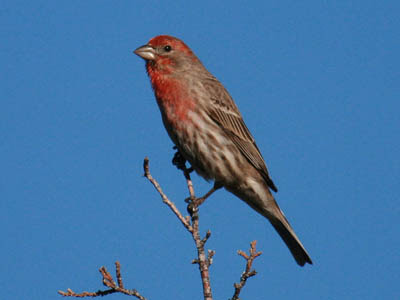 |
| Male House Finch. Greg Gillson. |
Males of this dusty brown striped finch have red limited to the head (specifically the forehead and eyebrow), breast (chest), and rump. The red coloration tends toward orangish, and may rarely be yellowish.
Females are streaked, similar to the males but without red. They lack any strong pattern on the face and head.
Note the small round head and curved upper ridge on the bill.
Some people call these red-headed sparrows. Sparrows and finches are similar, but in general, male finches are brighter than the females and tend to hang out more in trees. Sparrow genders are usually quite similar in coloration and tend to feed mostly on the ground.
These birds are common in residential areas, especially at bird feeders. In the West more widespread in arid regions near water.
House Finches are year-round residents in southern Minnesota.
Ruby-throated Hummingbird
These red-throated birds are the only hummingbird nesting in the eastern United States.

Males are dark green above and on the belly. They have a white upper chest. The throat is ruby-red.
Females are green above, white below, including white throat.
These birds are found in woodland edges, residential yards. Readily come to hummingbird feeders.
Ruby-throated Hummingbirds are summer residents throughout Minnesota.
Rose-breasted Grosbeak
These birds with the red breast and huge pink bill sing beautiful robin-like songs from the tops of trees.
 |
| Male Rose-breasted Grosbeak. Susan Killian. Pixabay. |
Males have black hood and upper parts. White under parts. Large white wing patches. Huge pink bill. Inverted bright red triangle on the breast.
Females are brown above, face with broad stripes, white throat. The under parts are buff with many thin brown streaks. Pale bill.
These birds inhabit deciduous and mixed forests. Shade trees in town. Come to feeders.
Rose-breasted Grosbeaks are summer residents throughout Minnesota.
Purple Finch
Forest finches of the foothills, delicately frosted in pinkish-red.
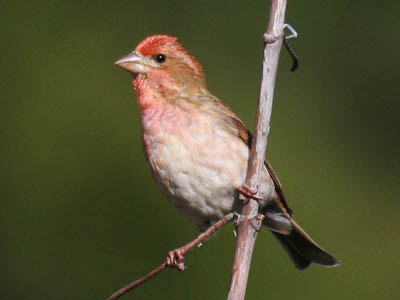 |
| Male Purple Finch. Greg Gillson. |
Told from more common House Finch by bigger square or peaked head, bigger bill, lacks sharp striping below, deeply notched tail. Red covers all plumage.
Females lack red color, shows strongly patterned dark ear patch outlined all around with a pale stripe, is heavily streaked below.
Found in foothills and damp mountains conifers and mixed woods. Visit feeders, but less frequently than House Finches.
Purple Finches are year-round residents in northeastern Minnesota, winter visitors throughout.
Common Redpoll
These frosty pink and red birds are northern relatives of the goldfinches.
 |
| Common Redpoll. Greg Gillson. |
These birds are frosty white in winter with brown striping above and on the sides. Both genders have red caps, black around bill and chin. Adult males have red upper breast. Immatures less red.
These birds are found in weedy fields and alder and birch trees in winter. Come to thistle feeders.
Common Redpolls are winter visitors throughout Minnesota.
Pine Grosbeak
These are red-headed finches of northern forests.
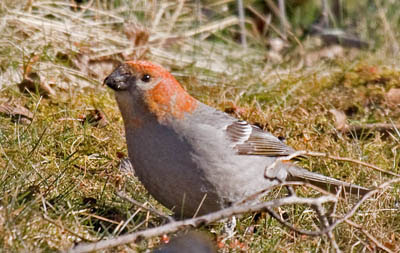 |
| Pine Grosbeak. Greg Gillson. |
Birds are gray with 2 white wing bars. Males have red heads, females yellow. They are a bit larger than House Finches.
They summer in northern spruce and fir forests, winter in fir and ash trees barely to the northern United States. Will come to feeders.
Pine Grosbeaks are winter visitors to northern Minnesota.
Orange birds of Minnesota
True orange-colored birds are not that common. Many birds that I have here are paler rusty.
The common pattern is an orange body and black or brown wings and tail. Another common pattern is for the orange to be restricted to the under parts.
The following are orange birds that you are most likely to see in Minnesota.
Barn Swallow
These orange-bellied birds are a familiar sight across North America in summer.
 |
| Barn Swallow. Greg Gillson. |
These birds are purple-blue above with orange under parts and long forked tails. The color of the underparts in winter or on females are often cinnamon or buff-colored, but breeding males can be brighter orange-red.
These birds swoop low over fields and wetlands at lower elevations. They may build their mud nests in rafters on porches, garages, or other out-buildings.
Barn Swallows are summer residents throughout Minnesota.
Red-breasted Nuthatch
These active little red-breasted birds crawls all around on the trunk and big branches of conifers. They search crevices in the bark for insect food.
 |
| Red-breasted Nuthatch. Greg Gillson. |
These tiny birds have blue-gray backs and a black line through a white face. Some males can have quite bright rusty red under parts. Some females can have quite pale buff-colored under parts. Most birds show an orange-cinnamon breast color.
Found nearly exclusively in conifers. Readily come to feeders.
Red-breasted Nuthatches are year-round residents in northeastern Minnesota, winter visitors throughout Minnesota.
American Redstart
In flight these small warblers flash orange or yellow in the wing and base of the tail.
 |
| American Redstart. Dennis Jarvis. Flikr. CC BY-SA 2.0 |
Males are black above, white on the belly. They have bright orange patches on side of breast, wings, and base of the tail.
Females are grayer, especially on the head. The orange of males is replaced by yellow on the females.
These birds are found in regenerating woods after a clear cut, and willow tangles along streams.
American Redstarts are summer residents throughout Minnesota.
Baltimore Oriole
These bright orange and black birds are fairly common breeders in wooded areas in the East.
 |
| Baltimore Oriole. Michael McGough. Pixabay. |
Males are have a black hood and back. Wings black with white patches. Tail black with orange sides to the base. Bright orange under parts.
Females are similar to males, but more olive above, less black. Immature birds for their first year or more are olive above orangish-yellow on the breast, fading to yellow on the belly. Two white wing bars.
These birds are common in deciduous woods, shade trees.
Baltimore Orioles are summer residents throughout Minnesota.
Brown Thrasher
These are rather large rusty-orange songbirds.
 |
| Brown Thrasher. Linda Jones CC0. |
The upper parts of these birds is colored rusty-brown to orange. They show two white wing bars. Under parts are buff with heavy reddish-brown streaking.
These birds live in woodland edges and mature backyard landscaping.
Brown Thrashers are summer residents throughout Minnesota.
Yellow birds of Minnesota
Yellow is a common bird color! Often it is mixed with black and white plumage in birds.
Many birds with darker upper parts have yellow breast or belly.
The following are yellow birds you are most likely to see in Minnesota.
American Goldfinch
These small little birds are bright yellow and black.
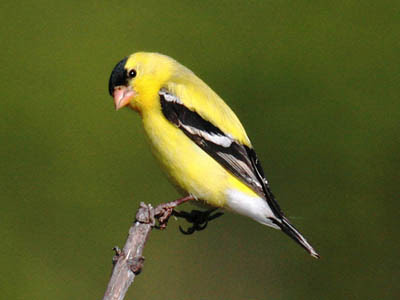 |
| American Goldfinch. Greg Gillson. |
Males are bright lemon yellow with black and white wings and tail, black cap. White under tail coverts. Pink bill.
Females are duller yellow below and brownish above. Lack black cap.
Winter birds are pale brown or gray, a touch of yellow on the throat of males.
These are birds of open country, fields with saplings, clear cuts, residential areas. They avoid dense forests, mountains, deserts. They visit feeders.
American Goldfinches are year-round residents in southern Minnesota, summer residents in northern Minnesota.
Northern Flicker
These woodpeckers spend much time eating ants on the ground.
 |
| Northern Flicker. Greg Gillson. |
These birds are larger than robins with brown and black barred upper parts. The underparts are pink with round black spots. There is a black crescent across the chest. When they fly away from you they reveal a large white rump.
Western birds have salmon-red under wings and under tail. Those in the East are colored yellow. The male face differs between the two populations–black whisker on the eastern birds, red whisker on western birds. Intergrades from overlap on Great Plains common. These may show male facial characteristics of both populations, or yellow-orange flight feathers.
These birds live in open woods with bare ground for foraging, residential yards.
Northern Flickers are year-round residents throughout Minnesota.
Common Yellowthroat
These buttery yellow birds are abundant in the marsh vegetation.
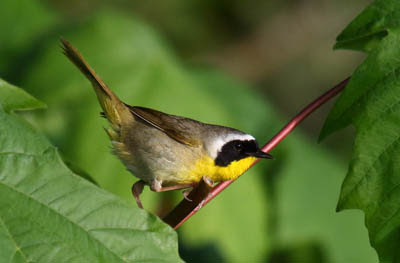 |
| Male Common Yellowthroat. Greg Gillson. |
These skulkers have bright yellow throats and yellow undertail coverts. Males have a black domino mask edged broadly in white, which females lack. Upperparts are dull olive-green.
Immature males in fall show a shadowed black mask.
Found in damp situations and heavy deciduous brambles following clear cuts.
Common Yellowthroats are summer residents throughout Minnesota.
Yellow-rumped Warbler
These are abundant warblers across North America. Affectionately called “butter butts” by many birders, because of their bright yellow rumps that flash in flight.
 |
| Breeding Yellow-rumped (Myrtle) Warbler. Greg Gillson. |
Western form (Audubon’s) with bright yellow throat and yellow rump. Large white wing patch.
Northern and Eastern form (Myrtle) with white throat, yellow rump, and two white wing bars.
Winter birds are dull gray brown, with bright yellow rump. Throat may be cream colored or white. Often difficult to tell the two forms apart in winter.
 |
| Winter Yellow-rumped Warbler. Greg Gillson. |
Breed in mountain or boreal conifers. Widespread in migration. Winter in low river bottoms, open weedy deciduous areas. Rarely come tofeeders in winter.
Yellow-rumped Warblers are summer residents in northeastern Minnesota, spring and fall migrants throughout.
Cedar Waxwing
These crested birds with yellow band on the end of the tail are often found in flocks. They eat flying insects in summer, fruit and berries the rest of the year.
 |
| Cedar Waxwing. Greg Gillson. |
These birds are fawn-brown above, with dark gray wings and tail. They have a black mask and wispy crest. The belly is yellow. The wings have waxy red drops on the end of the tertials. The end of the tail has a brilliant yellow tail band.
They are found in open habitats with berries, including juniper woodlands and towns in winter.
Cedar Waxwings are year-round residents throughout Minnesota.
Yellow Warbler
The golden yellow sun packed all into one little bird! Appears to be an all-yellow bird.
 |
| Yellow Warbler. Greg Gillson. |
Some populations are bright yellow, some tend toward greenish on upper parts, some more golden. Yellow internal tail corners in flight.
Males with red breast streaking, again, variable by population.
Females somewhat to much paler yellow, some greenish, some whitish. Lack red streaks.
These birds are found in willow thickets on the edge of wetlands and ditches, stream sides in arid regions.
Yellow Warblers are summer residents throughout Minnesota.
Great Crested Flycatcher
These flycatchers have long tails and big heads with big bill and bright yellow belly.
 |
| Great Crested Flycatcher. Simard Francois. Pixabay. |
These birds are gray on the face and breast, brownish on rest of upper parts. Bright lemon yellow belly. The under side of the tail and some feathers of the wing are cinnamon colored.
These birds stay in the canopy of open woods.
Great Crested Flycatchers are summer residents throughout Minnesota.
Nashville Warbler
These birds with the bright yellow underparts do a good job of hiding!
 |
| Nashville Warbler. Greg Gillson. |
These birds are gray above. The throat and breast and under tail coverts are bright lemon yellow. The belly is white. They have a complete white eye ring.
Females are just a bit paler than males.
These birds are found in re-growing clear cuts, and understory brush in open woods.
Nashville Warblers are summer residents in northeastern Minnesota, spring and fall migrants throughout.
Pine Siskin
These small brown-streaked birds are relatives of the goldfinches. But you would never know it until they fly and sport yellow wing stripes and tail base. Usually in flocks.
 |
| Pine Siskin. Greg Gillson. |
These birds are streaked brown. In flight they have a yellow stripe down the length of the wing. The sides of the base of the tail is also yellow. Some birds are paler, some darker, others brighter yellow, others duller.
These birds are found in summer in northern conifer woods. Irregularly irrupt hundreds of miles southward. Frequent at feeders.
Pine Siskins are year-round residents in northeastern Minnesota, winter visitors throughout.
Palm Warbler
This rather drab bird has bright yellow under tail coverts. It tends to spend much time on the ground in disturbed soils. It constantly bobs its tail up and down.
 |
| Winter Palm Warbler. Greg Gillson. |
Breeding birds are rather gray with yellow throat, vent and under tail coverts. White eyebrow stripe. Chestnut cap. Eastern birds tend to be more yellowish on the breast.
In winter birds are very pale, but with yellow under tail.
They nest in bogs within boreal forests. They like similar habitat at other times of year: open land with isolated scrubby trees or bushes, including coastal scrub.
Palm Warblers are summer residents in northernmost Minnesota, spring and fall migrants throughout.
Dickcissel
These yellow birds often flock together in weedy roadside edges.
 |
| Dickcissel. RebelAT. CC By-SA 3.0 |
These are gray birds with yellow breast and eyebrow.
Males have a black band across the lower throat. They have a large chestnut patch on the shoulder.
Females paler, lack black chest band.
They are found in prairie grasslands and weedy patches.
Dickcissels are rare summer residents in southern Minnesota.
Yellow-throated Vireo
Vireos are slow moving small birds that sing throughout the day. These yellow-headed vireos are one of the most colorful of their clan.
 |
| Yellow-throated Vireo. MDF. CC BY-SA 3.0 |
These birds are blue-gray above, white below. Two white wing bars. Their head is olive yellow with yellow spectacles around the eye, and bright yellow throat.
These birds like large tracts of unbroken deciduous or mixed woodlands. Interestingly, however, they are often found on forest edges.
Yellow-throated Vireos are summer residents throughout most of Minnesota.
Yellow-headed Blackbird
These blackbirds with yellow heads are found in marshes in the West.
 |
| Yellow-headed Blackbird. Greg Gillson. |
Males are glossy black with bright golden-yellow head and breast. White wing patches.
Females are duller brown with mottled yellow breast.
These birds nest in cattail marshes in prairies. Winter in large flocks in agricultural areas.
Yellow-headed Blackbirds are summer residents throughout most of Minnesota, absent in northeastern Minnesota.
Wrapping Up
Minnesota, “Land of 10,000 Lakes”, boasts a vibrant tapestry of feathered friends, many adorned with stunning plumage. While I have focused on red, orange and yellow common birds, there are many other colorful birds you might encounter in the state:
Woodland Beauties:
- Scarlet Tanager: Males flaunt a fiery crimson body, black wings, and black wing bars. Look for them in open woodlands and deciduous forests during breeding season.
- Rose-breasted Grosbeak: Males showcase a rosy-red breast, black head with white wing bars, and a brown back. Find them in open woodlands, edges of fields, and even backyards with feeders.
- Indigo Bunting: Males exhibit a deep blue body with black streaks and a white wing bar. Their high-pitched song adds melody to woodlands and shrubby areas.
- Cedar Waxwing: These bohemian beauties possess silky gray plumage, a bright yellow band across their tail, and a distinctive red wax-like tip on some wing feathers. They’re often seen in flocks, flitting through forests and orchards.
Open Country Jewels:
- Western Meadowlark: The state bird of North Dakota, the Meadowlark exhibits a bright yellow breast, black bib, and white V on its back. Their melodious song resonates across open fields and meadows.
- Bobolink: Males showcase a black and white body pattern with a buffy wing patch and a distinctive white rump. Listen for their bubbling song as they soar over meadows and grasslands.
- Common Yellowthroat: These energetic warblers sport a bright yellow throat, olive-green body, and white wing bars. They flit through low vegetation in fields, marshes, and meadows.
Frequently Asked Questions
What is the difference between a Yellow Warbler and a Goldfinch?
Both Yellow Warblers and American Goldfinches are cheerful yellow birds, but they have several key differences in appearance, behavior, and habitat:
Appearance:
- Yellow Warbler: Slightly larger than a goldfinch with a slender body and long, pointed bill. Males are a vibrant lemon yellow with reddish streaks on the chest and olive streaks on the wings. Females are similar but less vibrant and lack the streaking.
- American Goldfinch: Smaller than a yellow warbler with a plump body and short, conical bill. Males are bright yellow with black wings and cap, while females are olive-yellow with gray wings and a yellow wing bar.
Behavior:
- Yellow Warbler: Active and acrobatic, foraging for insects and caterpillars in trees and shrubs. They have a bright, warbling song.
- American Goldfinch: Gregarious and often seen in flocks, especially in winter. They feed primarily on seeds, including thistle, and have a high-pitched, tinkling song.
Habitat:
- Yellow Warbler: Prefer open woodlands, forest edges, and riparian areas with willows and alders. They nest in low vegetation.
- American Goldfinch: Found in open fields, meadows, gardens, and backyards with feeders. They nest in trees and shrubs.
Here’s a table summarizing the key differences:
| Feature | Yellow Warbler | American Goldfinch |
|---|---|---|
| Size | Larger | Smaller |
| Body shape | Slender | Plump |
| Bill | Long, pointed | Short, conical |
| Male color | Yellow with reddish and olive streaks | Bright yellow with black wings and cap |
| Female color | Less vibrant yellow with olive streaks | Olive-yellow with gray wings and yellow wing bar |
| Behavior | Active, acrobatic, insectivorous | Gregarious, seed-eating |
| Habitat | Open woodlands, forest edges, riparian areas | Open fields, meadows, gardens, backyards |
By considering these differences, you can confidently identify whether you’ve spotted a yellow warbler or an American goldfinch next time you encounter a cheerful yellow bird!
What kind of bird has an orange belly in Minnesota?
Several bird species in Minnesota sport an orange belly, making identification a little tricky. Here are some possibilities, depending on other details you might remember about the bird:
Common possibilities:
- American Robin: These familiar birds have a warm rust-orange chest and belly, contrasting with their gray back. They’re abundant year-round in Minnesota and frequent various habitats, including backyards, parks, and woodlands.
- Baltimore Oriole: Males boast a striking black head and back, bright orange chest and belly, and white wing bars. Look for them in open woodlands, forest edges, and near rivers during spring and summer.
- Scarlet Tanager: Males showcase a fiery crimson body, including the belly, with black wings and black wing bars. They favor deciduous forests and woodlands during breeding season.
- Cedar Waxwing: These bohemian beauties possess silky gray plumage with a bright yellow band across their tail and a distinctive red wax-like tip on some wing feathers. Their underparts can sometimes appear orangey-brown in certain lighting conditions. They’re often seen in flocks, flitting through forests and orchards.
Are there scarlet tanagers in Minnesota?
Presence:
- Breeding: They are considered uncommon to rare breeders in Minnesota, primarily found in suitable habitat within the Eastern Broadleaf Forest and Laurentian Mixed Forest Provinces. Their primary breeding territory lies south of Minnesota, but nesting pairs have been confirmed in several counties, especially along the upper Minnesota River valley.
- Migrant: Scarlet Tanagers are more likely to be seen in Minnesota during migration periods, especially spring (late April to early June) and fall (late August to early October). They may appear in a wider range of habitats during these times, including open woodlands, forest edges, and even parks and backyards.
Habitat:
- Scarlet Tanagers favor deciduous forests and woodlands with tall trees, particularly oak, maple, and elm. They prefer areas with dense foliage for foraging and nesting.
Related Articles:
See photos and learn about the most common backyard birds in Minnesota, regardless of color.
See photos and learn what to feed winter birds in Minnesota.
Birds at your feeder in Minnesota
Here’s a quick tutorial of how I would teach you to identify birds: 7 Steps to Identify Birds!
Birds with red heads in North America.
Yellow-and-black birds in North America.










